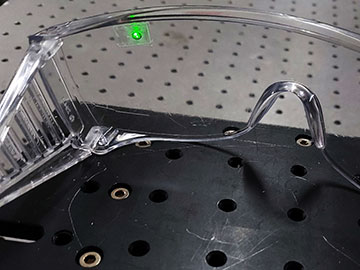![]()
Researchers developed a flexible and conformal holographic metasurface gas sensor. [Image: Courtesy of the researchers]
It is a harrowing scenario: Workers in a semiconductor plant unaware that the air they breathe is slowly being poisoned by rising levels of gas from a toxic industrial solvent. But before anyone gets sick or suffers serious harm, a visual alarm pops into view on workers’ safety goggles, instructing them to don protective masks and averting a wider crisis.
Developing such practical, wearable sensors that both detect and alert users to environmental threats in real time is a long-standing technology challenge—one that experts say would enhance safety in a variety of industrial, laboratory or military settings. Now, a multinational research team in South Korea and Pakistan reports an optics-based gas sensor that the team believes could be up to the task (Sci. Adv. doi: 10.1126/sciadv.abe9943).
Liquid crystals and holographic metasurfaces
The work marries the sensitivity of liquid crystals (LCs) with small, flexible holographic metasurfaces, says lead author Junsuk Rho, an associate professor in the departments of chemical and mechanical engineering at Pohang University of Science and Techology, Korea. The idea, he says, was “to create a miniaturized alarm system based on meta-holograms that can provide users with an instantaneous visual cue that a toxic gas is present.” The team’s inspiration, he adds, arose from previous work on holograms using metasurfaces of various functionalities, as well as metasurfaces combined with designer LCs.
In the new work, which the team hopes to commercialize, Rho says, the gas-sensing functionality is provided by the response of the LC cell to the toxic gas. The combined LC-integrated metasurface, he explains, is optimized to transmit different polarization states of light, which determine—based on the presence or absence of a toxic gas—the holographic visual alarm that’s produced.
Nanofabrication for stick-on sensors

The complete sensor, consisting of a flexible LC cell and a metasurface, is attached onto safety goggles and illuminated to display holographic images. [Image: Courtesy of the researchers]
What’s more, Rho says, using the team’s one-step nanocasting process, flexible, attachable metasurfaces might be mass produced for placement on a variety of surfaces.
“We envision that the sensors could be mounted simply to the gloves or glasses of the user,” Rho says. “Since there is no need for additional complex instrumentation or machinery to report the sensing of the gas, the system is extremely simple and effective compared to more involved implementations of gas sensors,” he adds.
Testing with a board marker
For the researchers’ proof-of-concept experiment, they fabricated a stick-on LC-integrated metasurface gas sensor for safety goggles. They chose a familiar and ubiquitous gas for the system to detect—fumes from a board marker.
In the absence of the volatile marker fumes, the team writes, the system maintained a right circularly-polarized beam that projected a holographic smiley face as a safety sign. Within a few seconds of exposure to fumes from the marker, however, the holographic image switched to an exclamation point warning sign as the gas converted the output beam to a left circularly-polarized orientation. The smiley face returned within a few seconds after removal of the gas.
The visual alarms the team used are but examples, Rho says. The meta-holograms could be tailored to project an illustration of a mask, for example, signaling a more specific instruction.
Monitoring other threats
The team also tested the response to a variety of gases—chloroform, acetone and toluene, to name a few—and found that detection speed is dependent on the type of gas and its concentration. This means, Rho says, that the sensor’s response could be designed for the detection of a specific gas or a specific dosage of gas. A platform to show a visual holographic representation of the amount of a toxic gas being detected is the topic of future work, he adds.
Detecting multiple gases simultaneously might prove difficult, however, since detection is provided by response of the LC cell. “We plan to continue research into the simultaneous detection of various gases, as well as accurate measurements of the concentration of the gas,” Rho says. “We also envision extending the technology to bio-substance detection, such as various bacteria or viruses including SARS CoV-2, which causes COVID-19.”
